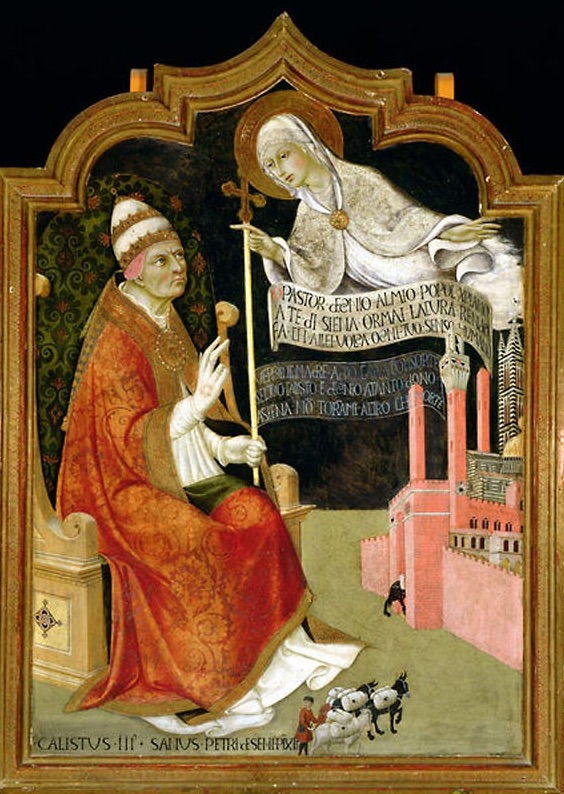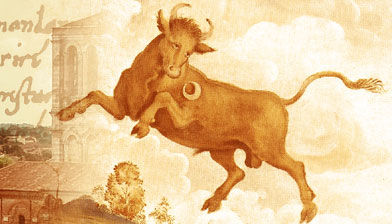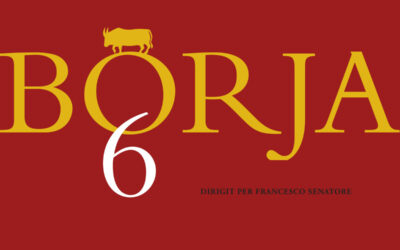My son, one day you will be the greatest jewel of your country and of your family, and receive the highest office a man can hold; you will honor me after my death, and I hope you will always live as virtuously as you do now. [The Dominican preacher Vincent Ferrer –future Saint Vincent Ferrer– to Alfonso de Borja, to whom he prophesied an exceptional rise in the ecclesiastical hierarchy.]
April 8th, 1455. An epoch-making day. The venerable cardinal of Valencia, Alfonso de Borja, an old legal expert and experienced diplomat, was appointed by the Sacred College as the successor of Nicholas V at the head of the Catholic Church. This outstanding event meant the high point of an exceptionally diplomatic and theological activity, but also a result of his powerful effect over contemporary statesmen and clergymen.
Fifteen days prior to the election, in the early hours of March 25th, 1455, Pope Nicholas passed away, following a ruthless disease. He was aged only 57. The late pontiff actively contributed to the rise of humanism and he also worked to rebuild the papacy and restore it to its old splendor, in times of peril and doom. The violent expansion of the Ottoman Empire –the great city of Constantinople being apocalyptically sacked by the armies of Mehmed II two years earlier– caused a deep and legitimate concern in the Eternal City. A terrible epoch of pain and sorrow, a turning point in world’s history.
After the pontiff’ death, there were nine days of traditional mourning and funeral ceremonies. The princes of the Catholic Church met once again in conclave, eight years away from the previous one. On April 3, fifteen cardinals gathered to begin the process of choosing the most capable and worthy occupant of Saint Peter’ Throne. At that time, five cardinals were not in Rome, including the powerful archbishop of Rouen, Guillaume d’Estouteville. The structure of the conclave was truly multinational: there were seven Italian cardinals (Fieschi, Ludovico Trevisan, Pietro Barbo, Latino Orsini, Calandrini, Domenico Capranica and Prospero Colonna), four Spaniards (Alfons de Borja, Juan de Torquemada, Carvajal and Antoni Cerdà i Lloscos), two Frenchmen (Alain de Coëtivy and Guillaume d’Estaing) and two Greeks (Isidore of Kiev and Basilios Bessarion).
The process of electing the Vicar of Christ was anything but an easy business. It was not just the mid fifteenth century’ conclave itself, its circumstances and proceedings, which we’ll specify below, but especially the schismatic history and ceaseless rivalry between Orsini and Colonna, the influential and dominating Roman families. “The Babylonian Captivity”, the 14th century heavy dispute that moved the papacy’ headquarters at Avignon, with French pontiffs only completely subordinated to the France’ monarchs, was still fresh in the mind of the cardinals. Shortly after the ending of this so-called “captivity”, the Catholics were once again divided, from 1378 to 1417, this time between Rome and Avignon. Two and even three popes were proclaimed or proclaimed themselves as the head of the Church, simultaneously claiming their legitimacy. This disunity, known as the Western Schism, and the Avignon papacy caused panic among the cardinals. They believed that the rightful supreme leader had to be Italian; if not Italian, it had to be a pope that the cardinals may easily control.
The ambiance of a conclave was severe and extremely pressing. In a fully isolated area, away from the outside world, strictly guarded by professionals, princes of the Church chose the supreme pontiff. The successor of Saint Peter. The Vicar of Christ. The single element of contact with the outside world was the delivering of food by personal servants, a proceeding carefully checked by bishops. This thorough verification was justified by the maintenance of absolute secrecy of the negotiations. None of the information from outside the Vatican was allowed to get inside and, also, no inside information was supposed to slip beyond the Apostolic Palace walls. Each cardinal spent their time for rest, meals and so on in extremely narrow spaces, almost suffocating, difficult to bear especially during the summer terrible heat.
The first round of elections took place under the sign of adversity between Colonna and Orsini. The influential Latino Orsini vs. his powerful enemy, Prospero Colonna. Prospero’ favorite was Domenico Capranica, the former secretary of Martin V (1417-1431), a member of the House of Colonna.
Cardinal Capranica was almost unanimously considered as the most virtuous and valuable candidate for the papal throne, a sincere reformist and a successful mediator. But, as usually in politics, his extraordinary qualities mattered less than the fact that he had the support of Colonna. This “sin” was essential in this particular situation –the pro-Colonna side had no majority whatsoever. On the other hand, Latino Orsini’ maneuvers aimed toward Pietro Barbo, Pope Eugene’ nephew, quite young for a fifteen years’ member of the Sacred College. Therefore, each of the two alternatives was harmful to the other party. By careful negotiations (intrigues), Prospero Colonna had to prevent the election of a pope potentially hostile to the interests of his family. Similarly, Orsini sought to block the majority favorable to a friend of his never-ending foes.
In such circumstances, a contender lacking an obvious partisan orientation, a candidate independent to the factions and their political games, seemed the best solution. Concession was the key in order to maintain the political balance. Basilios Bessarion, the Greek cardinal, one of the most prestigious scholars of his time, enjoyed the sincere esteem of some of his colleagues. Formerly Orthodox delegate at the Council of Basel (1434) and Florence (1439), Bessarion placed himself strongly on the Catholic side. For papacy, it was a strategic success and, accordingly, Pope Eugenius offered him the red hat. Although he was well-known for his virtues, his personal choice not to give up his beard (in contradiction with the canonical law) made him an unpredictable candidate or at least a suspicious one in the eyes of some contemporaries. He was voted by eight cardinals, being so very close to the Throne. But the French cardinals, Alain de Coëtivy especially, unequivocally opposed the election of a Greek with long beard who previously renounced the Orthodox faith. It was a convincing argument for other cardinals too.
Respectability, impartiality to Roman wealthy clans and diplomatic and ecclesiastical competencies were the quintessential attributes required for the next pope. In order to end the deadlock and the increasing tension caused by the vote against Bessarion, cardinals Coëtivy and Trevisan (the creator of the papal fleet that triumphed against the Ottomans in the summer of 1457), expressed their support for Alfonso de Borja from Valencia. Back in the old days, Borja was the protégé of Benedict XIII, antipope at Avignon, and the advisor of Alfonso V, king of Aragon and Naples. In terms of scientific expertise, his two doctorates in canon and civil law are eloquent. To his credit, he played a significant role in the historic reconciliation between Alfonso and Pope Eugenius and, therefore, he became cardinal in 1444. His contemporaries considered him an honorable cleric with great qualities and sincere piety, an illustrious scholar and a skilled diplomat.
The motion favoring cardinal of Valencia was, therefore, sustained by Trevisan, Orsini, Barbo, the French and Spanish cardinals, but also by Bessarion. Alfonso de Borja obtained the two-thirds majority by “accession” –the outspoken endorsement of the cardinals for a different candidate, a change of preference. It was the first time in the history of the Catholic conclaves when a member of the Sacred College gained the papal crown by this unusual procedure.
Indeed, Alfonso de Borja was not an “ordinary” clergyman. At the respectable age of 76, he became the first Spanish pontiff in history, under the name of Calixtus III. Vincent Ferrer’ premonition was fulfilled. For the next three years, he was not the obedient and isolated pope that many expected him to be. Quite the contrary. Calixtus III proved that age was not an obstacle for dynamism, challenges and ambitious projects.





